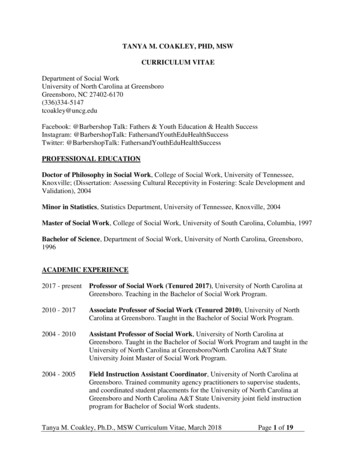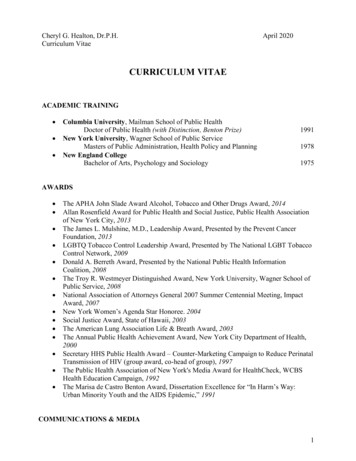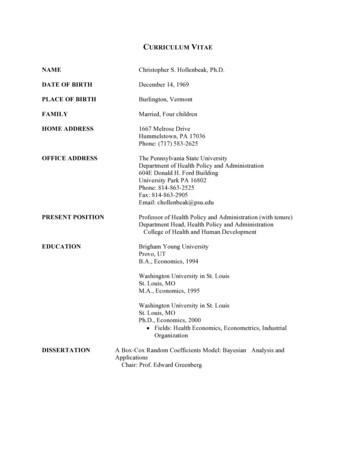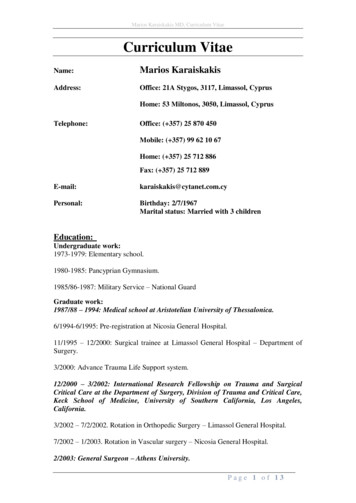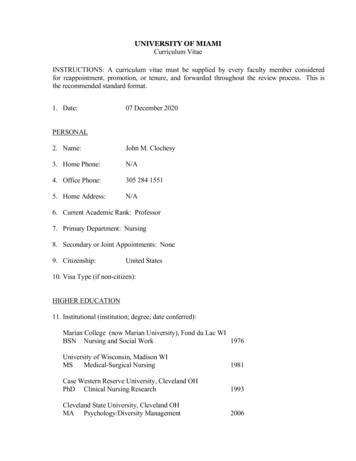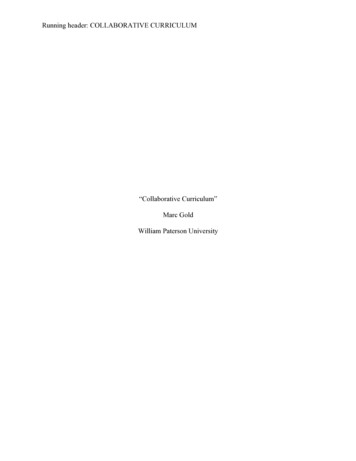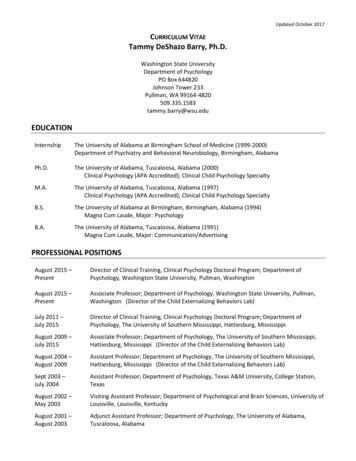
Transcription
Updated October 2017CURRICULUM VITAETammy DeShazo Barry, Ph.D.Washington State UniversityDepartment of PsychologyPO Box 644820Johnson Tower 233Pullman, WA InternshipThe University of Alabama at Birmingham School of Medicine (1999-2000)Department of Psychiatry and Behavioral Neurobiology, Birmingham, AlabamaPh.D.The University of Alabama, Tuscaloosa, Alabama (2000)Clinical Psychology (APA Accredited); Clinical Child Psychology SpecialtyM.A.The University of Alabama, Tuscaloosa, Alabama (1997)Clinical Psychology (APA Accredited); Clinical Child Psychology SpecialtyB.S.The University of Alabama at Birmingham, Birmingham, Alabama (1994)Magna Cum Laude, Major: PsychologyB.A.The University of Alabama, Tuscaloosa, Alabama (1991)Magna Cum Laude, Major: Communication/AdvertisingPROFESSIONAL POSITIONSAugust 2015 –PresentDirector of Clinical Training, Clinical Psychology Doctoral Program; Department ofPsychology, Washington State University, Pullman, WashingtonAugust 2015 –PresentAssociate Professor; Department of Psychology, Washington State University, Pullman,Washington (Director of the Child Externalizing Behaviors Lab)July 2011 –July 2015Director of Clinical Training, Clinical Psychology Doctoral Program; Department ofPsychology, The University of Southern Mississippi, Hattiesburg, MississippiAugust 2009 –July 2015Associate Professor; Department of Psychology, The University of Southern Mississippi,Hattiesburg, Mississippi (Director of the Child Externalizing Behaviors Lab)August 2004 –August 2009Assistant Professor; Department of Psychology, The University of Southern Mississippi,Hattiesburg, Mississippi (Director of the Child Externalizing Behaviors Lab)Sept 2003 –July 2004Assistant Professor; Department of Psychology, Texas A&M University, College Station,TexasAugust 2002 –May 2003Visiting Assistant Professor; Department of Psychological and Brain Sciences, University ofLouisville, Louisville, KentuckyAugust 2001 –August 2003Adjunct Assistant Professor; Department of Psychology, The University of Alabama,Tuscaloosa, Alabama
Tammy D. Barry, Ph.D.2Sept 2000 –August 2003Post-doctoral Research Coordinator; Department of Psychology, The University of Alabama,Tuscaloosa, Alabama. NIH-funded position; lab of John E. Lochman, Ph.D.Sept 2000 –August 2002Therapist and Clinical Supervisor (September 2000 – August 2002); Interim Director(January 2002 – June 2002); The University of Alabama Pervasive Developmental DisordersClinic, Tuscaloosa, AlabamaHONORS AND AWARDSWashington State University, College of Arts and Sciences, Institutional Service Award, 2017Council of University Directors of Clinical Psychology, Distinguished Service Award, 2017Honors College award for mentoring the top senior honor thesis for the College of Education and Psychology,2015Honors College award for mentoring the top senior honor thesis for the College of Education and Psychology,2013The University of Southern Mississippi Summer Research Grant Recipient, 2008College of Education and Psychology nominee for The University of Southern Mississippi Innovative AppliedResearch Award, 2007The University of Alabama at Birmingham Maternal and Child Health Leadership Education inNeurodevelopmental and Related Disabilities Project, Outstanding Former Trainee, 2006The University of Southern Mississippi Improvement of Instruction Summer Grant Recipient, 2005The University of Southern Mississippi Summer Research Grant Recipient, 2005C. J. Rosecrans Psychology Internship Award for Intern of the Year, UAB, 1999-2000The University of Alabama Department of Psychology Outstanding Dissertation Award, 2000The University of Alabama Department of Psychology Henry C. Rickard Clinical Service Award, 1999The University of Alabama Department of Psychology Outstanding Thesis Award, 1997GRANTS FUNDEDBarry, T. D., Marcus, D. K., & Arnau, R. C. (04/01/2011-03/31/14). Applying generalizability theory to themeasurement of externalizing disorders. Total Award: 73,250. Funding Source: National Institute of ChildHealth and Human Development, Grant No. 1R03HD061513-01A2. Status: Funded.Barry, T. D. (09/30/09-09/29/12). Parental involvement and consistent parenting practices as protective factorsfor preschoolers at risk for externalizing behaviors. Total Award: 49,945. Head Start Graduate Student ResearchGrant (Graduate Student/Research Scholar: Ferne A. Pinard; Principal Investigator/Mentor: Tammy D. Barry).Funding Source: U.S. Department of Health and Human Services, Administration for Children and Families, GrantNo. 90YR0040. Status: Funded.Kolbo, J., & Barry, T. D. (05/01/10-08/31/12). Project direction of ADHD collaborative care initiative and annualADHD and related disorders conference. Total Award: 179,196. Funding Source: Academic Performance SelfEsteem, Inc. (APSE). Status: Funded.Marcus, D. K., & Barry, T. D. (03/01/08-02/28/11). The latent structure of attention-deficit/hyperactivitydisorder. Total Award: 73,000. Funding Source: National Institute of Child Health and Human Development,Grant No. 1R03HD054667-01A1. Status: Funded.
Tammy D. Barry, Ph.D.Kolbo, J., & Barry, T. D. (05/15/07-08/31/10). Optimizing the collaborative care of Mississippi children withADHD. Total Award: 204,983. [Annual subcontracts: 85,430 (05/15/07-08/31/08); 66,774 (09/01/0808/31/09); 129,310 (09/01/09-08/31/10)]. Funding Source: USM subcontract with the Center for Promotion ofChild Development through Primary Care, Baltimore, MD as part of 795,000 (total) grant from The CISCOFoundation. Status: Funded.Echevarria, D. J., Barry, T. D., Greer, T., Nicholson, B. C., Marcus, D. K., & Zeigler-Hill, V. (07/01/08-05/30/10).General psychology course redesign. Total Award: 49,974. Funding Source: Mississippi Institutions of HigherLearning. Status: Funded.Kolbo, J., & Barry, T. D. (06/01/09-08/15/09). Supplement to optimizing the collaborative care of Mississippichildren with ADHD. Total Award: 2,014. Funding Source: Academic Performance Self Esteem, Inc. (APSE).Status: Funded.Heffer, R. W., & Barry, T. D. (10/1/05-9/30/08). Parenting techniques and characteristics associated withchildhood behavior problems. Total Award: 50,000; USM Subcontract (Principal Investigator, T. Barry): 17,221.Head Start Graduate Student Research Grant (Graduate Student/Research Scholar: Beth H. Garland). FundingSource: U.S. Department of Health and Human Services, Administration for Children and Families HHS-2005-ACFOPRE-YD-0068. Status: Funded.Barry, T. D. (4/1/01-9/30/02). Contrasting neuropsychological deficits associated with attentiondeficit/hyperactivity disorder versus aggression. Total Award: 6,888. Funding Source: U.S. Department ofJustice (COPS School Safety 2000). Subcontracted pilot project within Department of Justice Center grant, ID#2000CKWX0091. Status: Funded.OTHER SUBMITTED GRANTSBarry, T. D., Nicholson, B. C., & Jordan, S. S. (2012). Identification of and intervention with Early Head Startchildren at risk for negative psychosocial outcomes: The Enhanced Parenting Young Children Program. TotalCosts Requested: 871,998 (9/01/12-12/31/15). Funding Source: U.S. Department of Health and Human Services,Health Resources and Services Administration. Status: Unfunded.Barry, T. D., Nicholson, B. C., & Jordan, S. S. (2011). Identification of and intervention with Early Head Startchildren at risk for toxic stress: The Enhanced Parenting Young Children Program. Total Costs Requested: 1,858,199 (9/30/11-09/29/16). Funding Source: U.S. Department of Health and Human Services, Administrationfor Children and Families. Status: Unfunded.Kolbo, J., Barry, T. D., & Filce, H. (2009). Early identification of language, attention, and behavior problemsamong children in Mississippi schools. Total Costs Requested: 1,449,973 (09/01/09-08/31/13). Funding Source:Kellogg Foundation. Status: Unfunded.Riccio, C., & Barry, T. D. (2004). Substance use and aggression: Executive function process. Amount Requested: 1,273,125 (10/1/04-9/30/09). Funding Source: National Institute on Drug Abuse RFA-DA-04-009. Status:Unfunded.Burns, B. M., Barry, T. D., Davis, D. W., Bettler, R., & Chang. F. (2003). Developing attention abilities andacademic achievement: A longitudinal study of children between kindergarten and second grade. AmountRequested: 750,000 (9/1/03-8/31/06). Funding Source: United States Department of Education. Status:Unfunded.3
Tammy D. Barry, Ph.D.INTERNAL FUNDINGWhitney, P., Buchwald, D., Duncan, G., Gartstein, M., Barry, T. D., McGuire, M., Waters, S., et al. (08/01/1612/01/21). Research collaborative for addressing health disparities: A multilevel approach to health risks andresilience. Total Grant: 4,127,320. Funding Source: Washington State University Grand Challenge Grant. Status:Funded.Barry, T. D. (2008). Neuropsychological and contextual correlates of externalizing behaviors among economicallydisadvantaged preschoolers. Total Grant: 9,250, Funding Source: The University of Southern MississippiSummer Research Grant. Status: Funded.Barry, T. D. (2005). Restructuring of the Cognitive Assessment course. Total Grant: 9,250, Funding Source: TheUniversity of Southern Mississippi Summer Improvement of Instruction Grant. Status: Funded.Barry, T. D. (2005). Attentional abilities and academic readiness in at-risk preschoolers. Total Grant: 9,250,Funding Source: The University of Southern Mississippi Summer Research Grant. Status: Funded.EXTERNAL TRAINING CONTRACTSBarry, T. D., (07/01/12-09/30/13). Early fraction learning: Links to prosociality and self and other perspectivetaking. Total USM Subcontract: 17,906. Funding Source: USM subcontract with the University of South Alabamafor grant funded through the National Science Foundation to J. Cwikla and J. Vonk.Barry, T. D., & Jordan, S. S. (2014-2015). Boswell Regional Center Externship. Contract Amount: 13,800 total[09/01/14-08/31/15 (GR#-GR05379) 13,800].Jordan, S. S., & Barry, T. D. (2011-2015). Pine Grove Clinical Psychology Externship, Pine Grove BehavioralHealth. Contract Amount: 127,178 total [09/01/11-08/31/12 (GR01648) 31,568; 09/01/12-08/31/13(GR04388) 31,568; 09/01/13-08/31/14 (GR04388) 31,568; 09/01/14-08/31/15 (GR05152) 32,474].Jordan, S. S., & Barry, T. D. (2011-2015). SMSH Clinical Psychology Externship, South Mississippi State Hospital.Contract Amount: 84,176 total [09/01/11-08/31/12 (GR03405) 21,044; 09/01/12-08/31/13 (GR03405) 21,044; 09/01/13-08/31/14 (GR03405) 21,044; 09/01/14-08/31/15 (GR05151) 21,044].Jordan, S. S., & Barry, T. D. (2011-2015). Baptist Children’s Village Clinical Externship, Baptist Children’s Village.Contract Amount: 47,120 total [09/01/11-08/31/12 (GR02735) 11,780; 09/01/12-08/31/13 (GR04671) 11,780; 09/01/13-08/31/14 (GR04878) 11,780; 09/01/14-08/31/15 (GR05150) 11,780].Jordan, S. S., & Barry, T. D. (2011-2012). Pine Belt Clinical Psychology Externship, GR01645. Pine Belt MentalHealthcare Resources. Contract Amount: 11,780 total.PUBLICATIONSPeer-Reviewed Journals* Denotes student project (including theses/dissertations) that I supervised, where the student or former student is the firstauthor.1.Tomeny, T. S., Barry, T. D., & Fair, E. C. (in press). Parentification of adult siblings of individuals with autismspectrum disorder: Distress, sibling relationship attitudes, and the role of social support. Journal ofIntellectual and Developmental Disability. http://dx.doi.org/10.3109/13668250.2016.12483764
Tammy D. Barry, Ph.D.2.Rankin, J. A., Tomeny, T. S., & Barry, T. D. (2017). Multi-informant assessment of siblings of youth withautism spectrum disorder: Parent-child discrepancies in at-risk classification. Research in DevelopmentalDisabilities, 68, 78-87.3.Tomeny, T. S., Barry, T. D., Fair, E. C., & Riley, R. (2017). Parentification of adult siblings of individuals withautism spectrum disorder. Journal of Child and Family Studies, 26, 1056-1067.4.Tomeny, T. S., Ellis, B. M., Rankin, J. A., & Barry, T. D. (2017). Sibling relationship quality and psychosocialoutcomes among adult siblings of individuals with autism spectrum disorder and individuals with intellectualdisability without autism. Research in Developmental Disabilities, 62, 104-114.5.Barry, T. D., Sturner, R. A., Seymour, K., Howard, B. H., McGoron, L., Bergmann, P., Kent, R., Sullivan, C.,Tomeny, T. S., Pierce, J. S., Coln, K. L., Goodlad, J. K., & Werle, N. (2016). School-based screening to identifychildren at risk for attention-deficit/hyperactivity disorder: Barriers and implications. Children’s Health Care,45 261-265.6.Tomeny, T. S., Baker, L. K., Barry, T. D., Eldred, S. W., & Rankin, J. A. (2016). Emotional and behavioralfunctioning of typically-developing sisters of children with autism spectrum disorder: The roles of ASDseverity, parental stress, and marital status. Research in Autism Spectrum Disorders, 32, 130-142.7.* Bader, S. H., Barry, T. D., & Hann, J. H. (2015). The relation between parental expressed emotion andexternalizing behaviors in children and adolescents with an autism spectrum disorder. Focus on Autism andOther Developmental Disabilities, 30, 23-34.8.Marsic, A., Berman, M. E., Barry, T. D., & McCloskey, M. S. (2015). The relationship between intentional selfinjurious behavior and the loudness dependence of auditory evoked potential in research volunteers.Journal of Clinical Psychology, 71, 250-257.9.* Bader, S. H., & Barry, T. D. (2014). A longitudinal examination of the relation between parental expressedemotion and externalizing behaviors in children and adolescents with autism spectrum disorder. Journal ofAutism and Developmental Disorders, 44, 2820-2831.10. Guelker, M. D., Barry, C. T., Barry, T. D., Malkin, M. M. (2014). Perceived positive outcomes as a mediatorbetween adolescent callous -unemotional traits and antisocial behavior. Personality and IndividualDifferences, 69, 129-134.11. McGoron, L., Sturner, R. A., Howard, B. J., Barry, T. D., Seymour, K., Tomeny, T. S., Morrel, T., Ellis, B. M., &Marks, D. (2014). Parents’ goals for ADHD care in a clinical pediatric sample. Clinical Pediatrics, 53, 949-959.12. * Tomeny, T. S., Barry, T. D., & Bader, S. H. (2014). Birth order rank as a moderator of the relation betweenbehavior problems among children with an autism spectrum disorder and their siblings. Autism, 18, 199-202.13. Barry, T. D., Marcus, D. K., Barry, C. T., & Coccaro, E. F. (2013). The latent structure of oppositional defiantdisorder in children and adults. Journal of Psychiatric Research, 47, 1932-1939.14. * Garland, B. H., Barry, T. D., & Heffer, R. W. (2013). Parenting techniques as a mediator between femalecaregivers’ internalizing symptoms and externalizing behaviors among preschool-aged children. NHSADialog: A Research-to-Practice Journal for the Early Childhood Field, 16, 148-171.15. * Garland, B. H., Barry, T. D., & Heffer, R. W. (2013). The role of inconsistent discipline and parentalinvolvement on female caregivers’ internalizing symptoms and externalizing behaviors among preschoolaged children. NHSA Dialog: A Research-to-Practice Journal for the Early Childhood Field, 16, 211-215.16. * Tomeny, T. S., & Barry, T. D. (2013). Review of social skills training for children with Asperger syndromeand high-functioning autism. Journal of Autism and Developmental Disorders, 43, 498-499.5
Tammy D. Barry, Ph.D.17. Barry, T. D., Lochman, J. E., Fite, P. J. Wells, K. C., & Colder, C. R. (2012). The influence of neighborhoodcharacteristics and parenting practices on academic problems and aggression outcomes among moderatelyto highly aggressive children. Journal of Community Psychology, 40, 372-379.18. * Tomeny, T. S., Barry, T. D., & Bader, S. H. (2012). Are typically-developing siblings of children with anautism spectrum disorder at risk for behavioral, emotional, and social maladjustment? Research in AutismSpectrum Disorders, 6, 508-518.19. Barry, T. D., Pinard, F. A., Barry, C. T., Garland, B. H., & Lyman, R. D. (2011). The utility of home problempervasiveness and severity in classifying children identified with attention-deficit/hyperactivity disorder.Child Psychiatry and Human Development, 42, 152-165.20. * Henderson, J. A., Barry, T. D., Bader, S. H., & Jordan, S. S. (2011). The relation among sleep, routines, andexternalizing behavior in children with an autism spectrum disorder. Research in Autism Spectrum Disorders,5, 758-767.21. Marcus, D. K., & Barry, T. D. (2011). Does attention-deficit/hyperactivity disorder have a dimensional latentstructure: A taxometric analysis. Journal of Abnormal Psychology, 120, 427-442.22. * Walker, A. N., Barry, T. D., & Bader, S. H. (2010). Therapist and parent ratings of changes in adaptive socialskills following a summer treatment camp for children with autism spectrum disorders: A preliminary study.Child Care and Youth Forum, 39, 305-322.23. * Bader, S. H., & Barry, T. D. (2009). Review of Autism frontiers: Clinical issues and innovations. Journal ofAutism and Developmental Disorders, 39, 1495-1496.24. Barry, T. D., Dunlap, S. T., Lochman, J. E., & Wells, K. C. (2009). Inconsistent discipline as a mediator betweenmaternal distress and aggression in boys. Child and Family Behavior Therapy, 31, 1-19.25. Barry, T. D., Barry, C. T., Deming, A., & Lochman, J. E. (2008). Stability of psychopathic characteristics inchildhood: The influence of social relationships. Criminal Justice and Behavior, 35, 244-262.26. Barry, T. D., Thompson, A. R., Barry, C. T., Lochman, J. E., Adler, K., & Hill, K. R. (2007). The importance ofnarcissism in predicting proactive and reactive aggression in moderately to highly aggressive children.Aggressive Behavior, 33, 185-197.27. Pardini, D. A., Barry, T. D., Barth, J. M., Lochman, J. E., & Wells, K. C. (2006). Self-perceived social acceptanceand peer social standing in children with aggressive-disruptive behaviors. Social Development, 15, 46-64.28. Barry, T. D., Dunlap, S. T., Cotten, S. J., Lochman, J. E., & Wells, K. C. (2005). The influence of maternal stressand distress on disruptive behavior problems in boys. Journal of the American Academy of Child andAdolescent Psychiatry, 44, 265-273.29. * Wohlford, K. E., Lochman, J. E., & Barry, T. D. (2004). The relation between chosen role models and theself-esteem of men and women. Sex Roles, 50, 575-582.30. Barry, T. D., Klinger, L. G., Lee, J. M., Palardy, N., Gilmore, T., & Bodin, S. D. (2003). Examining theeffectiveness of an outpatient clinic-based social skills group for high-functioning children with autism.Journal of Autism and Developmental Disorders, 33, 685-701.31. Williams, S. C., Lochman, J. E., Phillips, N. C., & Barry, T. D. (2003). Aggressive and non-aggressive boys’physiological and cognitive processes in response to peer provocations. Journal of Clinical Child andAdolescent Psychology, 32, 568-576.32. Barry, T. D., & Lochman, J. E. (2002). Behavioral assessment: Principle over practice? ContemporaryPsychology: The APA Review of Books, 47, 145-148.6
Tammy D. Barry, Ph.D.33. Barry, T. D., Lyman, R. D., & Klinger, L. G. (2002). Academic underachievement and attentiondeficit/hyperactivity disorder: The negative impact of symptom severity on school performance. Journal ofSchool Psychology, 40, 259-283.34. Barry, T. D., Klinger, L. G., Lyman, R. D., Bush, D., & Hawkins, L. (2001). Visual selective attention versussustained attention in boys with attention-deficit/hyperactivity disorder. Journal of Attention Disorders, 4,193-202.35. Lochman, J. E., FitzGerald, D., Gage, S., Kanaly, K., Whidby, J., Barry, T. D., Pardini, D., & McElroy, H. (2001).Effects of a social cognitive intervention for aggressive deaf children: The Coping Power Program. Journal ofthe American Deafness and Rehabilitation Association, 35, 38-61.36. Barry, C. T., Frick, P. J., (Barry) DeShazo, T. M., McCoy, M. G., Ellis, M. E., & Loney, B. R. (2000). Theimportance of callous-unemotional traits for extending the concept of psychopathy to children. Journal ofAbnormal Psychology, 109, 335-340.37. (Barry) DeShazo, T. (1998). A review of the Conner’s continuous performance test as a clinical tool. ChildAssessment News, 6, 9-12.Books (Authored or Edited)38. Barry, C. T., Kerig, P. K, Stellwagen, K. K., & Barry, T. D. (Eds.). (2011). Narcissism and Machiavellianism inyouth: Implications for the development of adaptive and maladaptive behavior. Washington, DC: AmericanPsychological Association.39. Barry, T. D., Bader, S. H., & Tomeny, T. S. (2010). Enhancing communication in children with an autismspectrum disorder. In F. A. Karnes & K. R. Stephens (Eds.), The practical strategies series in autism education.Austin, TX: Prufrock Press.40. Barry, T. D. (2009). An introduction to children with autism. In F. A. Karnes & K. R. Stephens (Eds.), Thepractical strategies series in autism education. Austin, TX: Prufrock Press.Book Chapters and Other Contributions41. Barry, T. D., Lindsey, R. A., Fair, E. C., & DiSabatino, K. M. (2017). Parent psychopathology. In J. E. Lochman &W. Matthys (Eds.), The Wiley Handbook of Disruptive and Impulse-Control Disorders (pp. 275-290). Hoboken,NJ: Wiley Press.42. Barry, T. D., & DiSabatino, K. M. (2017). Externalizing disorders. A. Wenzel (Ed.), The SAGE Encyclopedia ofAbnormal and Clinical Psychology, Vols 1-7 (pp. 1404-1406). Thousand Oaks, CA: Sage Publications.43. Barry, T. D., & Ellis, B. M. (2017). Down syndrome. A. Wenzel (Ed.), The SAGE Encyclopedia of Abnormal andClinical Psychology, Vols 1-7 (pp. 1188-1190). Thousand Oaks, CA: Sage Publications.44. Barry, T. D., & Fair, E. C. (2017). Autism Diagnostic Observation Schedule. A. Wenzel (Ed.), The SAGEEncyclopedia of Abnormal and Clinical Psychology, Vols 1-7 (pp. 368-372). Thousand Oaks, CA: SagePublications.45. Barry, T. D., & Fisher, K. (2017). Attention-deficit/hyperactivity disorder: Diagnosis. A. Wenzel (Ed.), TheSAGE Encyclopedia of Abnormal and Clinical Psychology, Vols 1-7 (pp. 336-337). Thousand Oaks, CA: SagePublications.46. Barry, T. D., & Hansen, L. (2017). Risk for autism spectrum disorder. A. Wenzel (Ed.), The SAGE Encyclopediaof Abnormal and Clinical Psychology, Vols 1-7 (pp. 393-394). Thousand Oaks, CA: Sage Publications.7
Tammy D. Barry, Ph.D.47. Powell, N. P., Lochman, J. E., Boxmeyer, C. L., Barry, T. D., & Pardini, D. A. (2017). The Coping Power Programfor aggressive behavior in children. In J. R. Weisz & A. E. Kazdin (Eds.), Evidence-based psychotherapies forchildren and adolescents, third edition (pp. 159-176). New York: Guilford Publications.48. Barry, T. D., Fisher, K., DiSabatino, K. M., & Tomeny, T. S. (2016). Distractibility: Interrupted by an inability toignore. In V. Zeigler-Hill & D. K. Marcus (Eds.), The Dark Side of Personality (pp. 189-207). Washington, DC:American Psychological Association.49. Barry, T. D., Goodlad, J. K., Tomeny, T. S., & Fair, E. C. (2015). Group social skills intervention for adolescentswith Asperger syndrome or high-functioning autism spectrum disorder: Curriculum, process, and outcomes.In. M. Shaughnessy (Ed.), Asperger Syndrome: Risk Factors, Cognitive-Behavioral Characteristics andManagement Strategies (pp. 181-196). New York: Nova Biomedical Books.50. Barry, T. D., Grafeman, S. J., Bader, S. H., & Davis, S. E. (2011). Narcissism, positive illusory bias, andexternalizing behaviors. In C. T. Barry, P. K. Kerig, K. K. Stellwagen, & T. D. Barry (Eds.), Narcissism andMachiavellianism in youth: Implications for the development of adaptive and maladaptive behavior (pp. 159173). Washington, DC: American Psychological Association.51. Kimonis, E. R., Harrison, M., & Barry, T. D. (2011). Conclusion: Current themes, future directions, and clinicalimplications regarding narcissism and Machiavellianism in youth. In C. T. Barry, P. K. Kerig, K. K. Stellwagen,& T. D. Barry (Eds.), Narcissism and Machiavellianism in youth: Implications for the development of adaptiveand maladaptive behavior (pp. 251-268). Washington, DC: American Psychological Association.52. Barry, T. D., & Lochman, J. E. (2010). Oppositional defiant disorder. In I. B. Weiner & W. E. Craighead (Eds.),Corsini encyclopedia of psychology, 4th edition, Volume 3 (pp. 1129-1131). Hoboken, NJ: John Wiley & Sons,Inc.53. Boxmeyer, C., Barry, T. D., Lochman, J. E., Powell, N., Deming, A., & Young, L. (2010). Aggression in youngchildren: Information and strategies for parents and educators. In A. S. Canter, L. Z. Paige, & S. Shaw (Eds.),Helping children at home and school III: Handouts for families and educators (S4H3). Bethesda, MD: NationalAssociation of School Psychologists.54. Lochman, J. E., & Barry, T. D. (2010). Conduct disorder. In I. B. Weiner & W. E. Craighead (Eds.), Corsiniencyclopedia of psychology, 4th edition, Volume 1 (pp. 383-385). Hoboken, NJ: John Wiley & Sons, Inc.55. Lochman, J. E., Barry, T. D., Powell, N., & Young, L. (2010). Anger and aggression. In D. W. Nangle, D. J.Hansen, C. A. Erdley, & P. J. Norton (Eds.), Practitioner’s guide to empirically based measures of social skills(pp. 155-166). New York: Springer.56. Lochman, J. E., Boxmeyer, C. L., Powell, N. P., Barry, T. D., & Pardini, D. (2010). Anger control training foraggressive youth. In A. E. Kazdin & J. R. Weisz (Eds.), Evidence-based psychotherapies for children andadolescents, second edition. New York: Guilford Publications.57. Powell, N. P., Lochman, J. E., Boxmeyer, C. L., Barry, T. D., & Young, L. (2010). The Coping Power program foranger and aggression in children: Targeting arousal and cognition. In W. F. Arsenio & E. A. Lemerise (Eds.),Emotions, aggression, and morality in children: Bridging development and psychopathology (pp. 239-258).Washington DC: American Psychological Association.58. Barry, T. D., Bader, S. H., Pinard, F. A., & Prentkowski, E. (2009). Aggressive behavior: Risk factors,assessment, and treatment. In C. Quin & S. Tawse (Eds.), Handbook of aggressive behavior research (pp.315-336). New York: Nova Science Publishers.59. Heffer, R. W., Barry, T. D., & Garland, B. H. (2009). History, overview, and trends in child and adolescentpsychological assessment. In J. L. Matson, F. Andrasik, & M. L. Matson (Eds.), Assessing childhoodpsychopathology and developmental disabilities (pp. 3-29). New York: Springer.8
Tammy D. Barry, Ph.D.60. Lochman, J. E., Barry, T. D., Powell, N., Boxmeyer, C. & Holmes, K. (2008). Externalizing conditions. In M. L.Wolraich, D. D. Drotar, P. H. Dworkin, & E. C. Perrin (Eds.), Developmental-behavioral pediatrics: Evidenceand practice (pp. 603-626). Philadelphia, PA: Mosby, Inc.61. Barry, T. D. (2006). PowerPoint Textbook Ancillary for Psychology by S. K. Ciccarelli & G. E. Meyer. UpperSaddle River, NJ: Pearson Education, Inc./Prentice Hall.62. Barry, T. D., & Lochman, J. E. (2005). Expulsion. In S. W. Lee (Ed.), Encyclopedia of school psychology (pp.199-200). Thousand Oaks, CA: Sage Publications.63. Lochman, J. E., Barry, T. D., & Salekin, K. L. (2005). Aggressive/oppositional behaviors (Oppositional Defiantand Conduct Disorders). In L. M. Osborn, T. G. DeWitt, L. R, First, & J. A. Zenel (Eds.), Pediatrics (pp. 15771585). Philadelphia, PA: Elsevier.64. Lochman, J. E., Barry, T. D., & Salekin, K. L. (2005). The Anger Coping and Coping Power Programs:Prevention and intervention with aggressive children. NIMH TherapyAdvisor website:http://therapyadvisor.com.65. Barry, T. D., & Lochman, J. E. (2004). Aggression in adolescents (pp. 1-5). Guidance Channel Ezine. WellnessReproductions and Publishing, LLC. Available on the World Wide Web:http://www.guidancechannel.com/ezine.asp?index 1479&cat 13.66. Barry, T. D., & Lochman, J. E. (2004). Aggression in young children: Strategies for parents and educators. InA. S. Canter, L. Z. Paige, M. D. Roth, I. Romero, & S. A. Carroll (Eds.), Helping children at home and school II:Handouts for families and educators (Section 4, pp. 1-4). Bethesda, MD: National Association of SchoolPsychologists.Spanish version: Barry, T. D., & Lochman, J. E. (2004). La agresión en los niños pequeños:Estrategias para padres y educadores. In A. S. Canter, L. Z. Paige, M. D. Roth, I. Romero, & S. A.Carroll (Eds.), Helping children at home and school II: Handouts for families and educators(Section 4, pp. 9-14). Bethesda, MD: National Association of School Psychologists.67. Barry, T. D., & Lochman, J. E. (2004). Aggression in adolescents: Strategies for parents and educators. In A. S.Canter, L. Z. Paige, M. D. Roth, I. Romero, & S. A. Carroll (Eds.), Helping children at home and school II:Handouts for families and educators (Section 4, pp. 5-8). Bethesda, MD: National Association of SchoolPsychologists.68. Barry, T. D., & Lochman, J. E. (2004). Oppositional defiant disorder. In W. E. Craighead & C. B. Nemeroff(Eds.), Concise Corsini encyclopedia of psychology and behavioral science, 3rd edition (pp. 645-647). Hoboken,NJ: John Wiley & Sons, Inc.69. Lochman, J. E., & Barry, T. D. (2004). Conduct disorder. In W. E. Craighead & C. B. Nemeroff (Eds.), ConciseCorsini encyclopedia of psychology and behavioral science. 3rd edition (pp. 212-214). Hoboken, NJ: JohnWiley & Sons, Inc.70. Barry, T. D., & Lochman, J. E. (2003). Social skills assessment. In T. H. Ollendick & C. S. Schroeder (Eds.),Encyclopedia of clinical child and pediatric psychology (p. 629-631). New York: Kluwer Academic/PlenumPress.71. Lochman, J. E., Barry, T. D., & Pardini, D. (2003). Anger control training for aggressive youths. In A. E. Kazdin& J. R. Weisz (Eds.), Evidence-based psychotherapies for children and adolescents (pp. 263-281). New York:Guilford Publications.9
Tammy D. Barry, Ph.D.CONFERENCE PRESENTATIONS* Denotes student project (including theses/dissertations) that I supervised, where the student or former student is the firstauthor.1.* Hansen, L. K., Lindsey, R. A., & Barry, T. D. (2017, November). Relations among parenting competence andactual and perceived knowledge of autism spectrum disorder. Poster accepted/to be presented at the 51stAnnual Conventi
Updated October 2017 CURRICULUM VITAE Tammy DeShazo Barry, Ph.D. Washington State University Department of Psychology PO Box 644820 Johnson Tower 233 Pullman, WA 99164-4820

